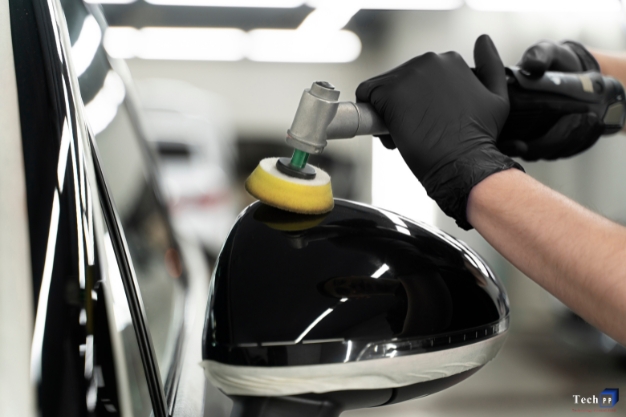Clear Bra vs Ceramic Coating! Protect your car’s paint with clear bras or ceramic coatings—two popular methods with distinct benefits. Clear bras shield against physical damage like road debris, while ceramic coatings provide chemical resistance and easier maintenance. Some combine both for maximum protection. This guide helps you choose the right option based on your needs, budget, and driving conditions.
What Is a Clear Bra?
A clear bra, also known as paint protection film (PPF), is a transparent urethane film applied directly to your car’s painted surfaces. This nearly invisible barrier acts as a sacrificial layer between your paint and the outside world.
How Clear Bras Work
Professional installers apply clear bras using precise measurements and cutting techniques. The film conforms to your car’s curves and contours, creating a seamless protective layer. Modern clear bras feature self-healing properties, meaning minor scratches disappear when exposed to heat from the sun or a heat gun.
Benefits of Clear Bras
Clear bras offer superior protection against physical damage. They absorb the impact from road debris, preventing chips and scratches that would otherwise reach your paint. The film also protects against insect stains, bird droppings, and tree sap.
High-quality clear bras maintain your car’s original appearance while adding a slight gloss enhancement. They’re particularly effective on high-impact areas like the front bumper, hood, and side mirrors. Clear tints like those available in Salt Lake City often come with warranties ranging from 5 to 10 years.
Drawbacks of Clear Bras
Cost represents the primary drawback of clear bras. Professional installation for a full vehicle can range from $3,000 to $7,000, depending on your car’s size and complexity. Partial coverage focusing on high-impact areas typically costs $1,500 to $3,000.
Installation requires significant skill and experience. Improper application can result in bubbles, lifting edges, or visible seams. Lower-quality films may yellow over time, though premium options resist discoloration for many years.
Understanding Ceramic Coatings
Ceramic coatings create a semi-permanent bond with your car’s paint using nanotechnology. These liquid polymer coatings cure to form a hard, glass-like layer that enhances your paint’s properties while providing protection.
How Ceramic Coatings Work
Professional application involves thorough paint preparation, including washing, clay barring, and sometimes polishing. The ceramic coating is then applied in thin, even layers and allowed to cure. The curing process can take several days to complete fully.
Benefits of Ceramic Coatings
Ceramic coatings transform your car’s paint into a hydrophobic surface that repels water, dirt, and contaminants. This makes washing easier and reduces the frequency of required maintenance. The coating also provides UV protection, preventing paint fade and oxidation.
The enhanced gloss and depth ceramic coatings provide often exceed your car’s original finish quality. Contaminants like bird droppings, tree sap, and road salt have difficulty bonding to the smooth ceramic surface, making removal safer and easier.
Most ceramic coatings last 2 to 5 years with proper maintenance, though some premium options claim longer durability. The coating maintains its properties throughout its lifespan without yellowing or hazing.
Drawbacks of Ceramic Coatings
Ceramic coatings don’t prevent physical damage from road debris. While they can reduce the severity of light scratches, they won’t stop rock chips or deep scratches like clear bras do. Professional application costs range from $1,000 to $3,000 for most vehicles.
The coating requires specific maintenance procedures. Regular washing with pH-neutral soaps is essential, and some car wash chemicals can damage the coating. Professional reapplication is necessary when the coating reaches the end of its lifespan.
Clear Bra vs Ceramic Coating: Direct Comparison
Protection Level
Clear bras provide superior physical protection against chips, scratches, and road debris. They’re designed to absorb impact and prevent damage from reaching your paint. Ceramic coatings excel at chemical protection and UV resistance but offer minimal impact protection.
For cars driven in harsh conditions with lots of road debris, clear bras offer better protection. For vehicles primarily concerned with environmental contaminants and ease of maintenance, ceramic coatings may be sufficient.
Cost Considerations
Initial costs vary significantly between the two options. Clear bras typically cost more upfront, especially for full vehicle coverage. However, they may prevent expensive paint repairs that could exceed the coating’s cost.
Ceramic coatings have lower initial costs but require reapplication every few years. When calculating long-term costs, consider both options’ maintenance requirements and longevity.
Maintenance Requirements
Clear bras require standard car care practices with some additional considerations. Avoid automatic car washes with harsh brushes, and be careful when removing snow or ice. The film’s self-healing properties reduce visible scratches over time.
Ceramic coatings demand more specific maintenance routines. Use only approved cleaning products and avoid contamination that could damage the coating. However, the hydrophobic properties make regular washing easier and more effective.
Appearance Impact
Both options can enhance your car’s appearance when properly applied. Clear bras add subtle gloss while maintaining your paint’s original look. Some car owners prefer the completely natural appearance clear bras provide.
Ceramic coatings often provide more dramatic visual improvements, with enhanced gloss and depth that can make your car’s paint appear richer and more vibrant. The choice often comes down to personal preference and desired aesthetic impact.
Making the Right Choice for Your Vehicle
Your driving conditions play a crucial role in determining the best protection method. Highway commuters facing constant road debris benefit most from clear bras’ impact protection. City drivers dealing with environmental contaminants might prefer ceramic coatings’ chemical resistance.
Budget considerations extend beyond initial costs. Factor in potential paint repair savings when evaluating clear bras, and consider ceramic coating reapplication costs over time. Some car owners invest in both options, applying clear bras to high-impact areas and ceramic coatings to the entire vehicle.
Your maintenance preferences also matter. If you enjoy detailing your car and want easier cleaning, ceramic coatings offer significant advantages. If you prefer minimal maintenance while maximizing protection, clear bras might be better suited to your needs.
Conclusion
Clear bras and ceramic coatings both protect your car’s paint but serve different purposes. Clear bras guard against physical damage like road debris, while ceramic coatings enhance appearance and make maintenance easier. Choose based on your driving habits, budget, and preferences, and consult professionals for advice and pricing.


